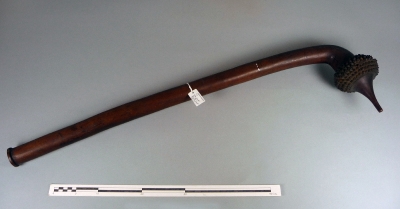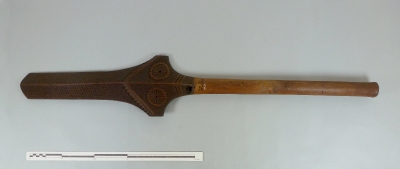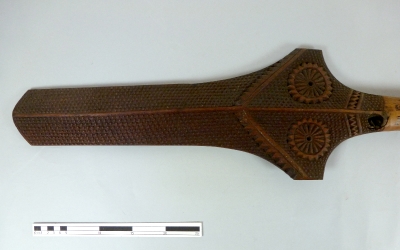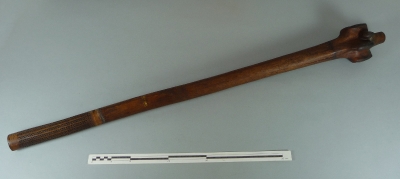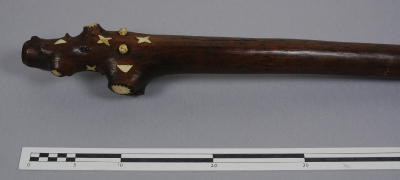To search the RPR site click here
Fijian Clubs
Fijian Clubs; 1884.12.101 .1, 1884.12.115 and 1884.12.105
Faye Belsey, Pitt Rivers Museum
There are 71 clubs from Fiji in the Founding collection. There is no doubt that this number of clubs is a result of Pitt River’s early interest in weapons. There is a great variety of club type from Fiji and other Pacific Islands. The variety of type of club in Fiji is not surprising given the nature of Fijian society. Warfare was part of everyday life on the islands where by the early 1800’s chaos reigned with local feuding and increasingly bloody civil wars becoming commonplace.
The different type of club illustrates that demand was great. The highly diversified array of Fijian war clubs reveals that the Fijian had devised a weapon for every type of stroke. Within the founding collection the variety of club type is evident. In this object biography I will discuss three different type of club.
1884.12.101.1 Totokia
The documentation for this club is as follows:
Accession Book IV entry - 1884.12.1 - 302 - Weapons Clubs Heavy club toka, with pointed head bent at right angle with a carved encircling raised band of knobbed rings behind the point Fiji (Ratzel 2.287) [Drawing]
?Black book entry - 382 - 384 Club mace headed carved and furnished with a wooden spike 382 - 385 shew gradual development of length of spike Fiji Is
Delivery Catalogue I entry - Maces and clubs from various countries Club with spike carved wood Fiji 431 Screen 13 178 179
Pitt Rivers Catalogue Entry (1874) - Screen 13 ... 431 to 434 Fiji curved clubs with spikes, called Toka; the form of which may be described as that of Nos 408, 409 and 410, bent on one side. [p77]
Additional Pitt Rivers Catalogue entry - Nos 431 to 434 are Fiji clubs called Toka. They are probably derived from an earlier form, resembling the Australian spiked clubs Nos 408 to 410, but curved to one side so as to present the point to the adversary [p67]
Written on object - FIJI P.R. coll [431]
Pitt Rivers Museum label - OCEANIA MELANESIA, FIJI. Wooden 'pineapple' club. Pitt Rivers Founding Collection, 1884.
This type of club is called a Totokia. Clubs were the foremost weapon used in warfare, the use of clubs often resulting in deadly consequences. This type of club was particularly lethal. This type of ‘beaked’ battle hammer club was an evolution from the Ai tuki battle hammer club with arched neck, heavy studded head and cone shaped ‘business end’. The development was the pointed ‘beaked’ end designed to ‘peck’ holes into the skull.
1884.12.115 Culacula
The documentation for this club is as follows:
Accession Book IV entry - 1884.12.1 - 302 - Weapons Clubs Club with cylindrical polished head and broad blade suggesting duck's head with rosettes for eyes carved all over into 'pimples' with hatching Fiji Group. [Drawing]
?Black book entry - 381 Mace headed club Curved ornamented with eyes Fiji Is
Delivery Catalogue I entry - Clubs Australian and Polynesian Club wood carved Fiji 498 and 499 Screen 14 172 173
Pitt Rivers Catalogue Entry (1874) - Screen 14 ... 499 to 501 Clubs. Varieties of the same form. Fiji Islands. [p80]
Additional Pitt Rivers Catalogue entry - ... the lower part of the blade and cross rib of this weapon ... has developed as to project far beyond the other parts and form a kind of cross bar with which to pick a hole in the enemy's skull. Nos 499 to 501 are varieties of the same form used in Fiji, Samoa and the Friendly Isles. [p70]
Pitt Rivers Museum label - OCEANIA MELANESIA, FIJI. Carved paddle club. Pitt Rivers Founding Collection, 1884.
Written on object - [on handle] FIJI IDS P.R. coll [499]
Written on object - [on handle] FIJI group P.R. coll.... [499] H.B. cat C.C. LXXVI
This club is a Culacula. Not all clubs were used for warfare. Fijian society was based on a system of interrelationships between groups, interresponsibilities and interexpectations. All of this especially relied on a series of ceremonial exchange. Exchanged were a range of material culture including all types of craftwork; mats, fans, bowls, sinnet, canoes, pots, fishing equipment, bark cloth, food and weapons including clubs. The decorative nature and form of this Culacula club suggests that it was unlikely used in warfare but more likely as a ceremonial object, possibly an item for exchange or for ceremonial use in dance and ritual. It is possible that such decorative clubs were also produced by the later half of the nineteenth century for trade to European visitors to the islands. The blade of the club is carved all over on both sides into raised ‘pimples’ and hatching with two rosette shapes carved at the broadest part of the blade suggesting the eyes of a duck’s head. These paddle clubs are Tongan or Samoan in origin. Particularly decorative clubs of the type exclusive to chiefs and priests were handed down as heirlooms. If used in warfare the broad blades of these clubs could also be used to shield impact from spears and arrows.
The second image of this club shows the carved broad blade head of 1884.12.115.
1884.12.105 Waka
The documentation for this club is as follows:
Accession Book IV entry - 1884.12.1 - 302 - Weapons Clubs Similar club [to 1884.12.104], with massive head Fiji or Tonga
Black book entry - 355 - 356 Clubs head formed by branching roots of tree studded with ivory Tongataboo [sic] Is
Delivery Catalogue I entry - Maces and clubs from various countries Club wood long Fiji 405 Screen 13 178 179
Pitt Rivers Catalogue Entry (1874) - Screen 13 ... 404 405 Long clubs of the same construction [ie the head of which is formed of the branching roots of a tree] formed of the branching roots of a tree studded with teeth. Tongataboo and Fiji. [p76]
Additional Pitt Rivers Catalogue entry - It has been supposed that the mace was suggested by the use of a small tree with the root torn up from the ground, the branching roots cut off and pointed to serve as spikes. Such clubs are used in the Tongataboo and Fiji Islands, Nos 403 to 405 and are called Maloma according to Wilkes ... [p65]
1862 Catalogue of objects owned by Pitt-Rivers - Catalogue of Arms belonging to Lt Col A. Lane Fox. Gren Guards taken at Park Hill House Clapham 21st August 1862 - 3. Tongatabu Club South Sea [could also be 1884.12.104]
Pre-PRM label - CLUB FIJI
Pitt Rivers Museum label - OCEANIA MELANESIA, FIJI or TONGA. Rootstock club. Original Pitt Rivers Founding Collection, 1884.
Written on object - FIJI or TONGA IDS. P.R. coll..... [405]. HB C. XXV.
This club is a rootstock club called Waka. The mace like head of the club is carved from the buttress roots of the uprooted sapling from which the club was made. The handle of the club is carved with zigzag design in relief, known as tavatava. The design has been interpreted as a pictorial representation of sennit binding and is a design borrowed from Fijian body art.
The role of the craftsman in Fijian culture was a much-valued skill and the woodcraftsmen in Fiji formed a distinct group in the community, with their own chiefs and specialists in making various items. Clubs were lovingly crafted and some clubs required years to make. Club carvers ‘matai ni malumu’ were highly skilled in selecting the correct type of wood for making the club and experienced enough to experiment with design as the variation in design and ornamentation on Fijian clubs attest to.
1884.12.104 Waka with inlaid ivory
Documentation for this club is as follows:
Accession Book IV entry - 1884.12.1 - 302 - Weapons Clubs Long stout club with root head and chip carved handle, the head knobs shell inlaid Fiji or Tonga
Black book entry - 355 - 356 Clubs head formed by branching roots of tree studded with ivory Tongataboo [sic] Is
Delivery Catalogue I entry - Maces and clubs from various countries Club wood Fiji 404 Screen 13 178 179
Pitt Rivers Catalogue Entry (1874) - Screen 13 ... 404 405 Long clubs of the same construction [ie the head of which is formed of the branching roots of a tree] formed of the branching roots of a tree studded with teeth. Tongataboo and Fiji. [p76]
Additional Pitt Rivers Catalogue entry - It has been supposed that the mace was suggested by the use of a small tree with the root torn up from the ground, the branching roots cut off, and pointed to serve as spikes. Such clubs are used in the Tongataboo and Fiji Islands, Nos 403 to 405 and are called Maloma according to Wilkes ... [p65]
1862 Catalogue of objects owned by Pitt-Rivers - Catalogue of Arms belonging to Lt Col A. Lane Fox. Gren Guards taken at Park Hill House Clapham 21st August 1862 - 3. Tongatabu Club South Sea [could also be 1884.12.105]
Written on object - 'FIJI or TONGA IDS. P.R.Coll.... (404). HB. C.XXIV.'
Pre-PRM label - (paper, stuck on, printed) 'CLUB. FIJI.' [JC 13 6 2003]
Pre-PRM label - (paper, stuck on, written) '404. LONG CLUB OF THE SAME CONSTRUCTION, FORM[ED] OF THE BRANCHING ROOTS OF A TREE, STUDDED WITH TE[ETH ?] TONGATABOO AND FIJI.'
This club is on display in the Museum on the Upper Gallery in case 31.A. It is also a rootstock Waka club with the head formed from the branching roots of the tree. In this instance the ends of the cut tree root have been inlaid with whale ivory shaped as stars and triangles. Often the number of kills by the warrior of a particular club was indicated by the inlay of human teeth or ivory around the head of the club or by the cutting of notches on the grip. A club with many kills to its credit was thought to achieve ‘mana’, with power and life of its own. A club achieving this status is the ultimate compliment to the warrior to whom the club belongs and the craftsman who made the club.
Further Reading:
Clunie, Fergus Yalo i Viti A Fiji Museum Catalogue. Fiji Museum, Suva, Fiji Islands 1986
Clunie, Fergus 'Fijian Weapons and Warfare'. Bulletin of the Fiji Museum No.2. Fiji Museum, Suva, Fiji Islands 1980
Churchill, William Club Types of Nuclear Polynesia. The Carnegie Institution of Washington, Washington 1917.
Ewins, Rod Fijian Artefacts Tasmanian Museum and Art Gallery Collection. Tasmanian Museum and Art Gallery, Tasmania, Hobart 1982.
Tippet, Alan Richard Fijian Material Culture A Study of Cultural Context, Function and Change. Bernice P. Bishop Museum Bulletin 232. Bishop Museum Press, Honolulu, Hawaii 1968
11 June 2012

